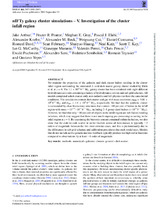| dc.contributor.author | Arthur, Jake | |
| dc.contributor.author | Pearce, Frazer R. | |
| dc.contributor.author | Gray, Meghan E. | |
| dc.contributor.author | Elahi, Pascal J. | |
| dc.contributor.author | Knebe, Alexander | |
| dc.contributor.author | Beck, Alexander M. | |
| dc.contributor.author | Cui, Weiguang | |
| dc.contributor.author | Cunnama, Daniel | |
| dc.contributor.author | Dave, Romeel | |
| dc.date.accessioned | 2018-11-15T07:17:50Z | |
| dc.date.available | 2018-11-15T07:17:50Z | |
| dc.date.issued | 2016 | |
| dc.identifier.citation | Arthur, J. et al. (2016). nIFTy galaxy cluster simulations – V. Investigation of the cluster infall region. Monthly Notices of the Royal Astronomical Society, 464: 2027 - 2038. | en_US |
| dc.identifier.issn | 0035-8711 | |
| dc.identifier.uri | http://dx.doi.org/10.1093/mnras/stw2424 | |
| dc.identifier.uri | http://hdl.handle.net/10566/4203 | |
| dc.description.abstract | We examine the properties of the galaxies and dark matter haloes residing in the cluster
infall region surrounding the simulated cold dark matter galaxy cluster studied by Elahi
et al. at z = 0. The 1.1 × 1015 h−1M galaxy cluster has been simulated with eight different
hydrodynamical codes containing a variety of hydrodynamic solvers and sub-grid schemes. All
models completed a dark-matter-only, non-radiative and full-physics run from the same initial
conditions. The simulations contain dark matter and gas with mass resolution mDM = 9.01 ×
108 h−1M and mgas = 1.9 × 108 h−1M , respectively. We find that the synthetic cluster
is surrounded by clear filamentary structures that contain ∼60 per cent of haloes in the infall
region with mass ∼1012.5–1014 h−1M , including 2–3 group-sized haloes (>1013 h−1M ).
However, we find that only ∼10 per cent of objects in the infall region are sub-haloes residing
in haloes, which may suggest that there is not much ongoing pre-processing occurring in the
infall region at z = 0. By examining the baryonic content contained within the haloes, we also
show that the code-to-code scatter in stellar fraction across all halo masses is typically ∼2
orders of magnitude between the two most extreme cases, and this is predominantly due to
the differences in sub-grid schemes and calibration procedures that each model uses. Models
that do not include active galactic nucleus feedback typically produce too high stellar fractions
compared to observations by at least ∼1 order of magnitude. | en_US |
| dc.language.iso | en | en_US |
| dc.publisher | Oxford University Press | en_US |
| dc.rights | This article is open access and copyright lies with the authors | |
| dc.subject | Numerical | en_US |
| dc.subject | Galaxies | en_US |
| dc.subject | Clusters | en_US |
| dc.subject | General | en_US |
| dc.subject | Dark matter | en_US |
| dc.title | nIFTy galaxy cluster simulations – V. Investigation of the cluster infall region | en_US |
| dc.type | Article | en_US |
| dc.privacy.showsubmitter | FALSE | |
| dc.status.ispeerreviewed | TRUE | |
| dc.description.accreditation | ISI | |

